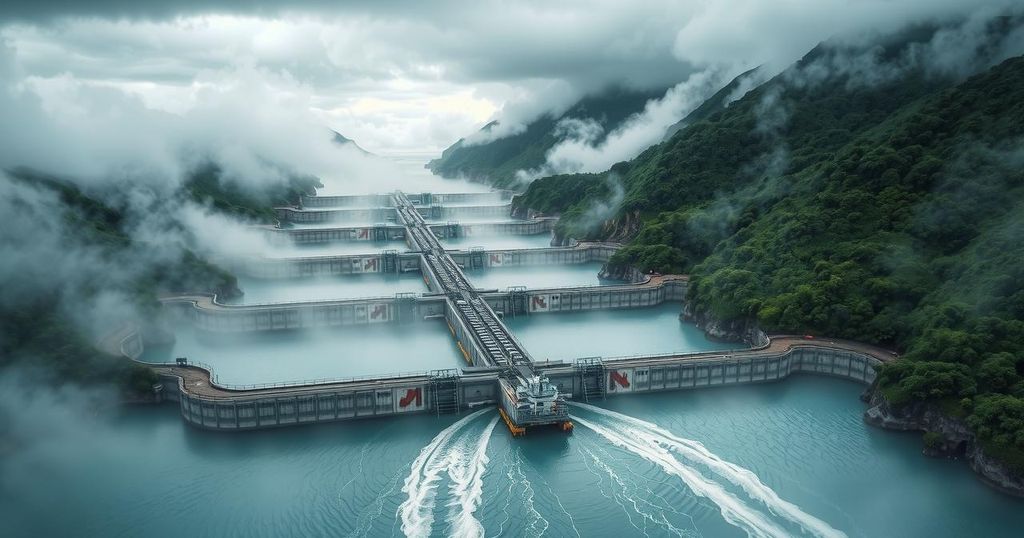The Panama Canal is an essential shipping route whose operations are increasingly impacted by climate change and rainfall fluctuations. It relies on adequate water levels in Gatun Lake, which have been threatened by a string of dry years coinciding with El Niño events. As global warming intensifies storm patterns and precipitation variability, future shipping efficiency could be compromised unless effective watershed management and research are prioritized. Despite recent challenges, current water levels provide optimism for improved shipping traffic in 2025.
The Panama Canal, a crucial 82-kilometer shipping route connecting the Pacific Ocean and the Caribbean Sea, has been vital for global trade since its inauguration in 1914. Its significance has gained increased attention in political discourse, with calls from prominent figures such as President Donald Trump and Secretary of State Marco Rubio urging the United States to reclaim ownership of the canal.
Recent climatic shifts, particularly changes in rainfall patterns, have increasingly impacted the canal’s operations. Data indicates that these alterations may intensify due to climate change, which threatens to create a more unpredictable future for shipping traffic through this essential route.
The canal relies on a lock system to navigate vessels, which can include massive Neopanamax ships transporting over 13,000 cargo containers, efficiently moving between oceans. As Mark Russo, Chief Science Officer at Everstream Analytics, notes, “Five percent of shipping globally traverses the Panama Canal; it is a critical artery for global trade.”
Water levels in Gatun Lake, critical for the canal’s operations, are influenced by precipitation essential for maintaining adequate ship passage. Despite Panama’s average rainfall exceeding 2,000 millimeters annually, the past three decades have featured three notably dry years, impacting operations and leading to reduced ship traffic and drafts.
Researchers emphasize the importance of understanding the intersection of supply chain logistics and climatic conditions, particularly as ships reserve passage well in advance. Russo states, “If you’re planning on your shipments through the Panama Canal, you can get out in front of those risks a year in advance.”
The recent water scarcity aligns with El Niño phenomena, correlating warmer Pacific waters with reduced precipitation. No conclusive evidence links climate change to shifts in the frequency of El Niño and La Niña cycles, which oscillate every two to seven years according to the El Niño-Southern Oscillation (ENSO).
As global warming progresses, the intensity of storms is expected to intensify, with increases predicted in the coming century. Rather than merely increasing average rainfall, extreme weather patterns could pose new challenges for the canal, as seen in 2010 when excessive rainfall temporarily closed operations due to safety concerns over dam integrity.
Efforts to enhance understanding of the Panama Canal’s hydrology, such as the Agua Salud Project led by the Smithsonian Tropical Research Institute, aim to stabilize Gatun Lake’s water levels through forest conservation. Improved watershed management is crucial in mitigating extreme weather impacts and ensuring efficient shipping operations.
Despite the challenges faced in recent dry years, there remains optimism for greater ship traffic in 2025 as current water levels in Gatun Lake are at their highest in five years, indicating a potential recovery for the canal’s operations.
The operations of the Panama Canal are increasingly influenced by climatic alterations, particularly concerning rainfall and extreme weather events. The reliance on consistent water levels in Gatun Lake is paramount, as fluctuations can significantly affect global shipping efficiency. Ongoing research and watershed management initiatives will be critical in navigating the challenges posed by climate change, ensuring that this vital shipping route continues to facilitate international trade effectively. Looking ahead, there is hope for improved conditions in the upcoming years, given the currently favorable water levels in Gatun Lake.
Original Source: eos.org




